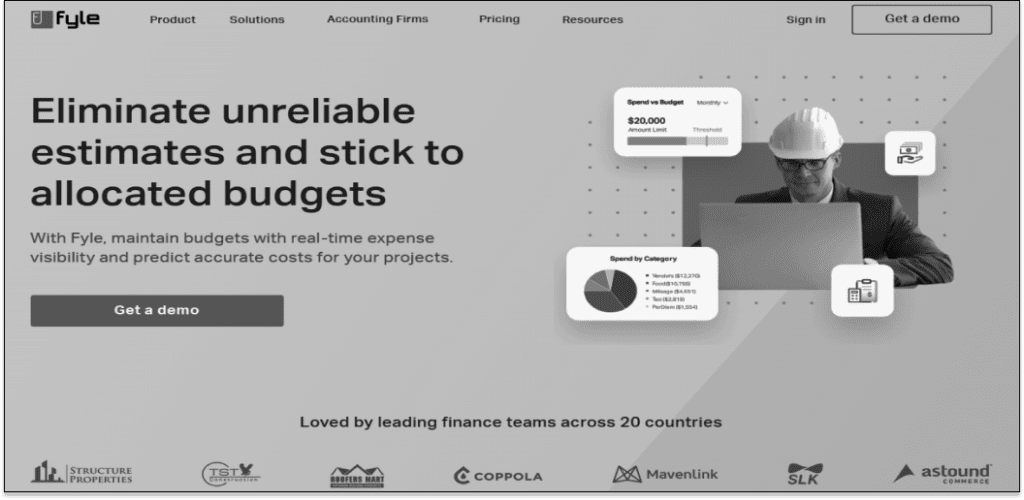Product marketing - what is it?
Product marketing is the process of introducing your product to your target market, positioning it as an ideal solution to their pressing needs, and persuading them to purchase it without being salesy.
That is why product marketing is considered one of the essential elements of any successful business strategy in today’s digital world.
It’s not just about selling a product; it’s about understanding what your customers want and need and showing them how your product can meet those needs better than anyone else.
All right. But is there any specific reason why businesses should focus on product marketing? Well, that’s a good question. So, let’s have a look at what businesses yield in return for putting much effort into product marketing.
Why should businesses focus on product marketing?
With the right messaging, marketing materials, distribution strategies, and pricing, you can create a compelling brand story that captures your audience’s attention and drives sales.
And with real-time data and analytics, you can continually measure and optimize your campaigns to ensure maximum ROI.
Let’s take the iPhone as an example to understand this in detail. Apple’s product marketing strategy focuses on the unique features and capabilities of the device, emphasizing its user-friendliness, privacy, and seamless integration with other Apple products.
By understanding its target audience and creating a distinct brand identity, Apple has established a loyal customer base and achieved unprecedented success.
Besides, people feel proud to own gadgets from Apple. That’s how powerful branding, as well as product marketing, is for businesses.
Bottom line?
Product marketing is non-negotiably inevitable for bringing your product (or service) in front of the eyes of your target audience, and inside their hearts too! Period.
In this article, we have covered two treasurable segments that you will be taking away to promote your offer (product or service) like a PRO!
- Decoded insights of how Fyle has marketed its product by fantastically positioning it on its landing page!
- The top fifteen tips to help you understand how you can market your product or service effectively. (P.S. Don’t miss it ; )
Now, let’s discover some essential product marketing insights by focusing on how Fyle has positioned its product on its website.
Wait a sec. First of all;
What or who is Fyle?
Fyle is a cloud-based platform that helps businesses simplify and automate their expense management and financial processes.
It facilitates users’ ability to easily manage expenses, create expense reports, and streamline reimbursements, while also offering other financial services such as invoice management, reconciliation, and accounting automation.
In short, Fyle aims to save businesses time, reduce errors, and allow them to focus on their core operations.
With that being said, let’s decode how Fyle has crafted copy for the product’s landing page and positioned its product strategically.
Decoding Fyle’s landing page
1) Hero section aka above the fold
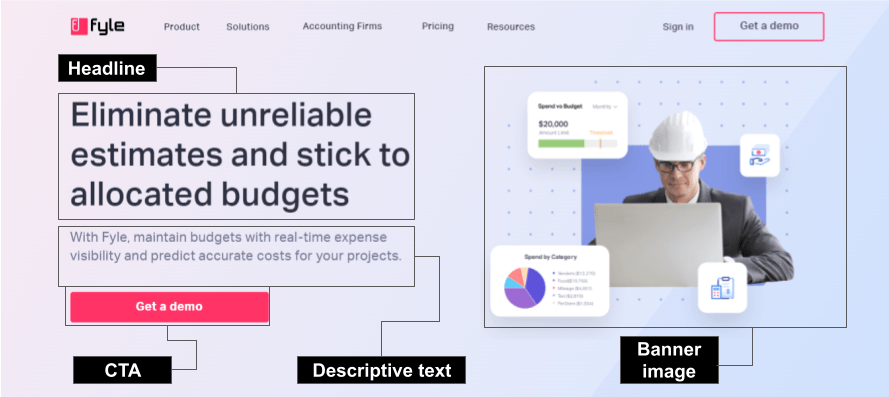
The hero segment entails 4 things. They are;
- Headline
- Descriptive text
- CTA
- And banner image
1.1) Headline
“Eliminate unreliable estimates and stick to allocated budgets.”
- A well crafted and customer-centric headline.
- It clearly emphasizes the struggle as well as the desire of the target audience.
- Struggle: Unreliable estimates and exceeding allocated budgets.
- Desire: Reliable estimates and staying within the allocated budgets.
- What is the secret behind crafting such a headline? Putting ourselves in the shoes of the customers & UNDERSTANDING them inside-out!
- That’s why understanding the target audience is the first and one of the best things to do before positioning your offer (product or service).
1.2) Descriptive texts aka subheadline
“With Fyle, maintain budgets with real-time expense
visibility and predict accurate costs for your projects.”
The subheadline focuses on the benefits of choosing Fyle.
It concisely tells what the target audience can do / get from the product of Fyle. Simply put, what is in it for them.
How does Fyle do it? By highlighting its benefits that bridge the gap between their struggles and successful scenarios.
It then becomes the reasons why the target audience should choose Fyle.
- In other words, it becomes the buyer’s motivation!
1.3) Banner image
- A catchy, relatable, and benefits-oriented banner image.
- The graphical representation, metrics, and calculation give website visitors the sneak peek of what they can expect inside.
- Overall, the banner image retains the attention of the website visitors with its conducive, and inquisitive visuals!
2) Showcasing the client base
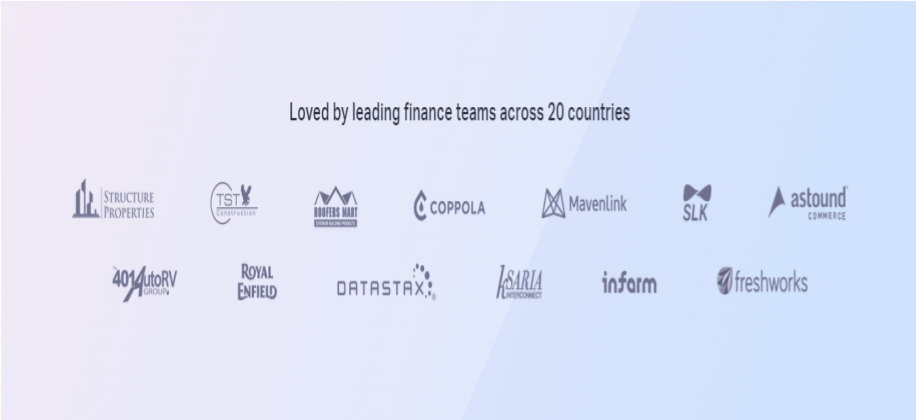
- Showcasing popular companies as clients is a form of social proof.
- But, why are they doing it?
- By showcasing the clients they have worked with, they are trying to build authority and trust. And you know what, it will work like a magic spell – implicitly influential!
- How? Consumer psychology is a key factor behind social proof. People instinctively prefer to select the option that is being chosen by the majority of people.
- Because they believe that if the majority of people choose something, then it must be worthy, safe, and purpose-fulfilling.
- Bottom line: Social proof sells!
3) Testimonials
Flaunting solution-oriented testimonials. Read the testimonial twice before reading what’s written afterwards.
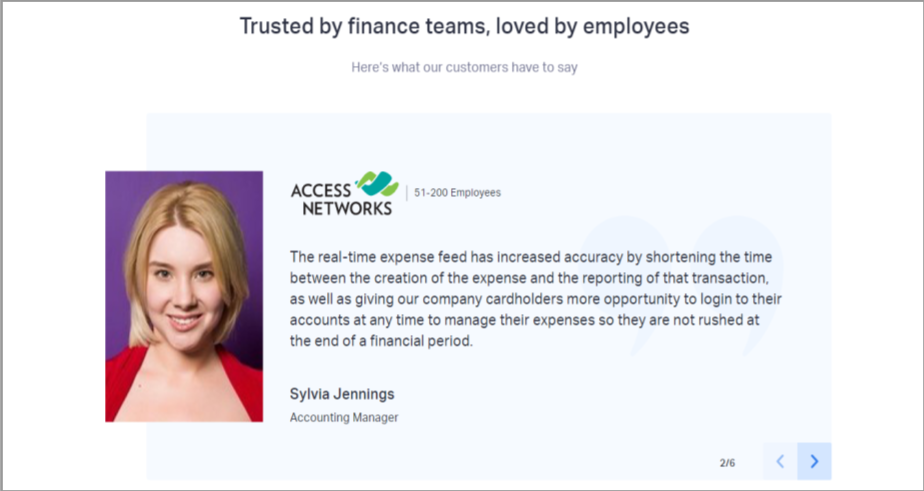
- The testimonial shown above clearly depicts how one of the features of Fyle streamlined the process of managing expenses in a beneficial way.
- This implies that Fyle has the capability to resolve the pain points of the target market, where the majority of people are facing the issue.
- This is how testimonials need to be structured. Simple, short, solution-oriented, and convincing the target audience by conveying the right message.
4) Features turned into benefits!
In the upcoming sections, Fyle has portrayed how some of its features were potentially beneficial to its client – “Quickbuild Construction Co.”
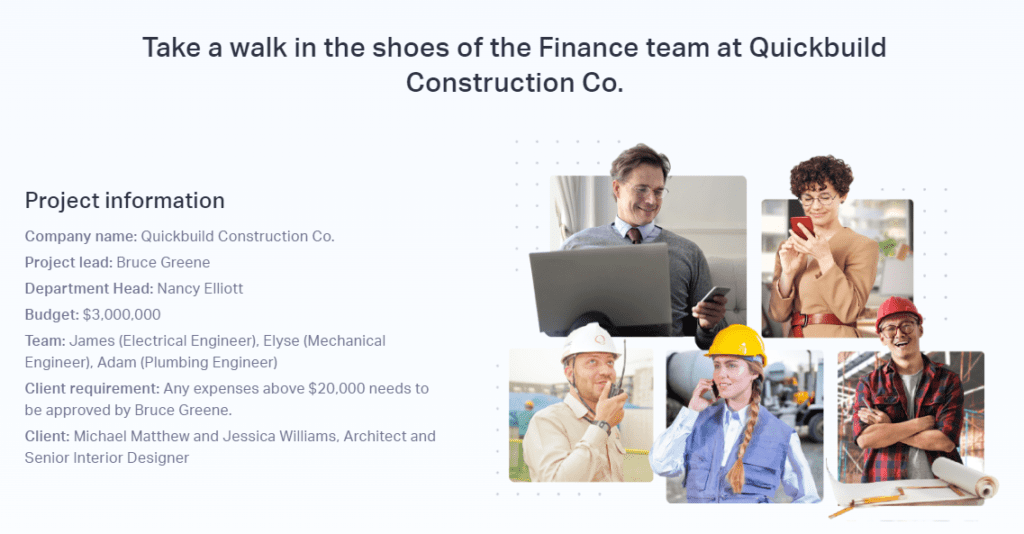
In the upcoming sections, Fyle has portrayed how some of its features were potentially beneficial to its client – “Quickbuild Construction Co.”
Let’s have a look at how Fyle has presented its features as potential benefits for Quickbuild Construction Co.
4.1) Feature: Project Expense Tracking
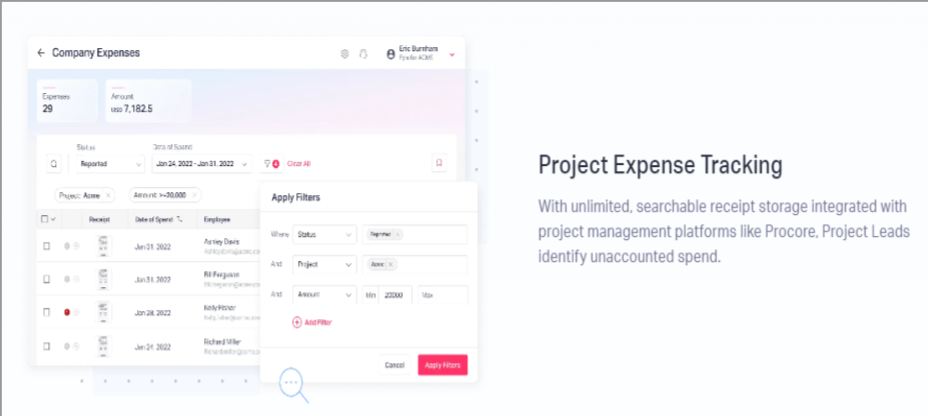
The image gives us an idea of how the interface of the feature looks.
The description of the feature explains how it streamlines a tedious task for project leads with its capabilities (unlimited as well as searchable storage and integration with other platforms).
Bottom line: A feature successfully solves a pain point for the target audience, and so it is presented as an irresistible solution they need (and the target audience in the same niche badly needs).
4.2) Feature: Reliable Cost Estimates
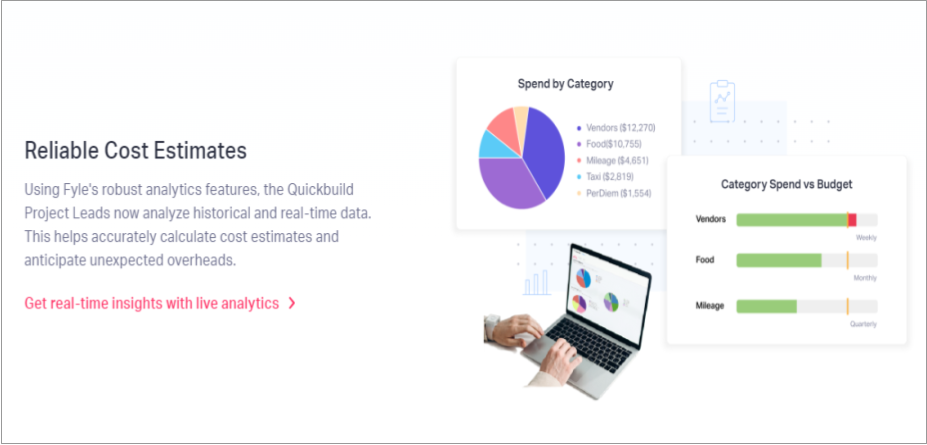
This section is pretty simple and straight-forward.
It quickly conveys how this feature is beneficial to the users with its succinct description and visuals that represent data in an easily digestible manner.
And in order to instill the importance of the benefits rendered by their features, they have interlinked dedicated landing pages accordingly.
For instance, the CTA “Get real-time insights with live analytics” redirects the user to the landing page of the analytics dashboard feature.
Likewise, Fyle has highlighted the most sought-after benefits of its features for the target audience with concise descriptions and impactful visuals as follows.
4.3) Feature: Tight Budget Controls
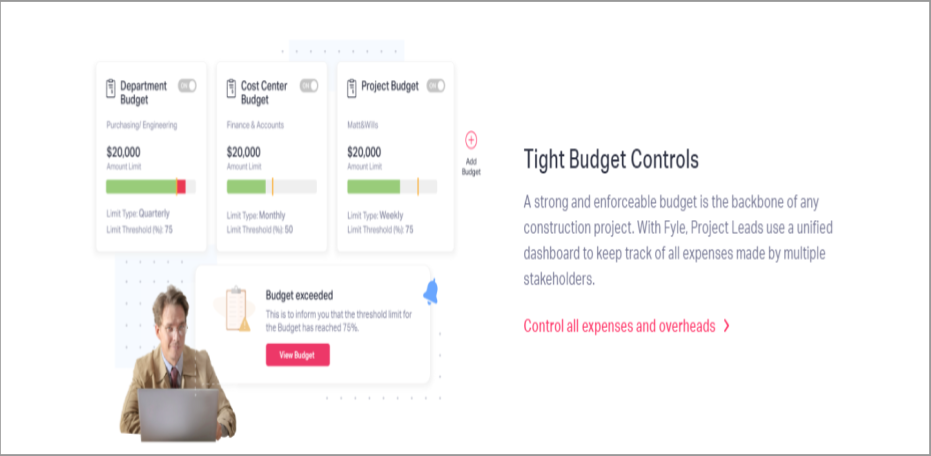
The description warms up the mindsets of the website visitors by emphasizing the importance of the budget.
CTA: “Control all expenses and overheads.” It evokes the curiosity of the target audience to click and learn more. But, how?
Here’s how: The CTA seems to be showing something that could be a smart solution to one of the most important yet tedious tasks of the target audience: “keeping track of all the expenses of multiple stakeholders.” Isn’t it?
It is! Bottomline: Fyle clearly and cleverly conveys the problems that the product solves!
4.4 ) Feature: Flexible Approval Features
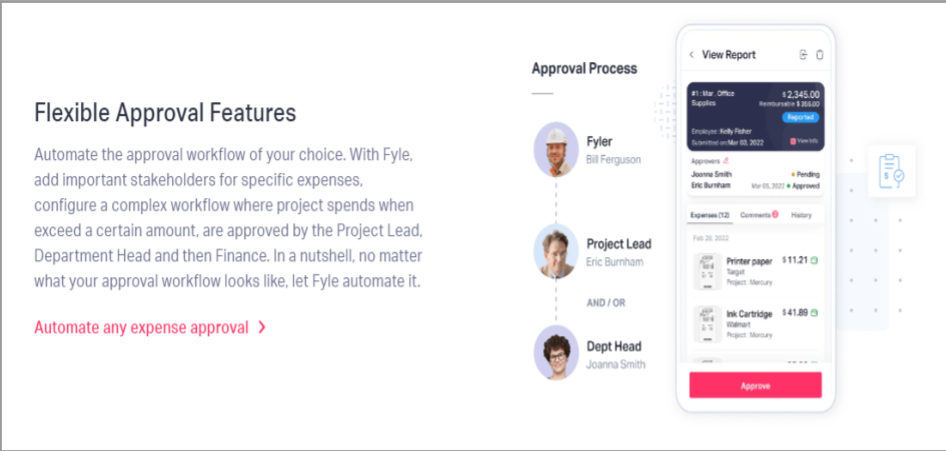
Fyle brings swiftness and simplicity to complex tasks through automation.
So, how does that benefit the target audience? It helps them get their job done effortlessly without any manual long haul.
4.5) Feature: Transparent Reimbursement Process

This feature focuses on helping employees submit and keep track of expenses on the go and receive prompt updates on their reimbursement status.
All the features showcased so far are positioned as if meticulously tailored to the needs of the target audience in such a way that they are too hard to resist.
5) Extra yet essential features!
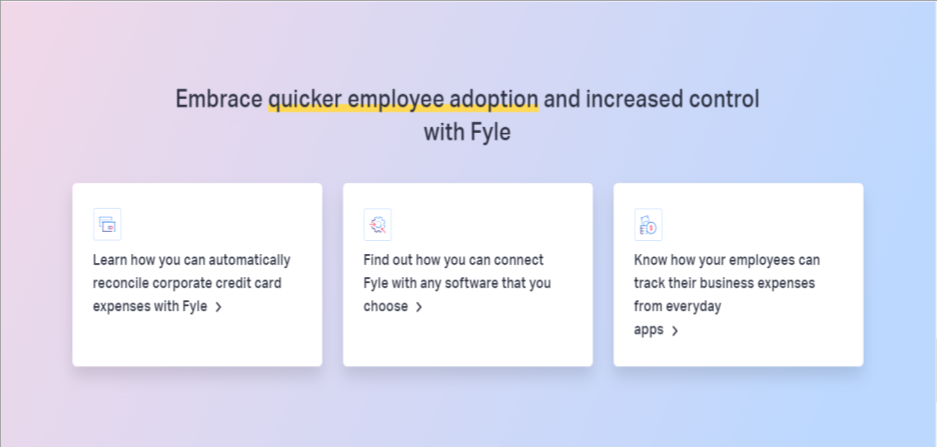
What do we have here? 3 more features are stacked side by side with the interlinks to their standalone landing pages.
By thoroughly understanding the scenarios and struggles of the customer persona, Fyle could craft killer copy that gives what the target audience wants or needs unsolicitedly.
It’s not about me, me, me – Fyle. It is all about the target audience, what they need, and how they can transition from a struggling state to a seamless, systematic state via the features of Fyle.
And the following are USPs, aka the 5 more reasons why people should choose Fyle:
Each reason has 3 essential elements:
- A visual walk-through image.
- A headline aka a reason.
- A one line description that tells what they can do with the specific superpower (reason backed by beneficial features) or how they make the lives of the target audience easier.
A picture is worth a thousand words. And so, feast your eyes with the following snapshots while having an eye for the essential elements!
#1 USP
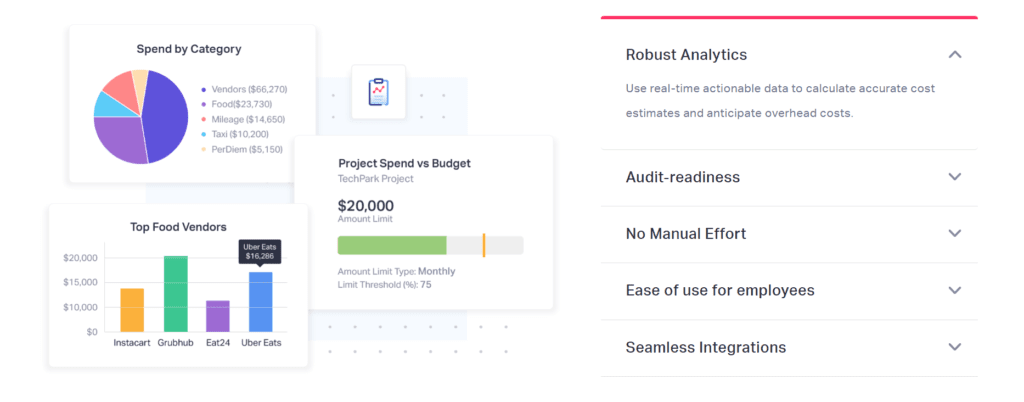
#2 USP
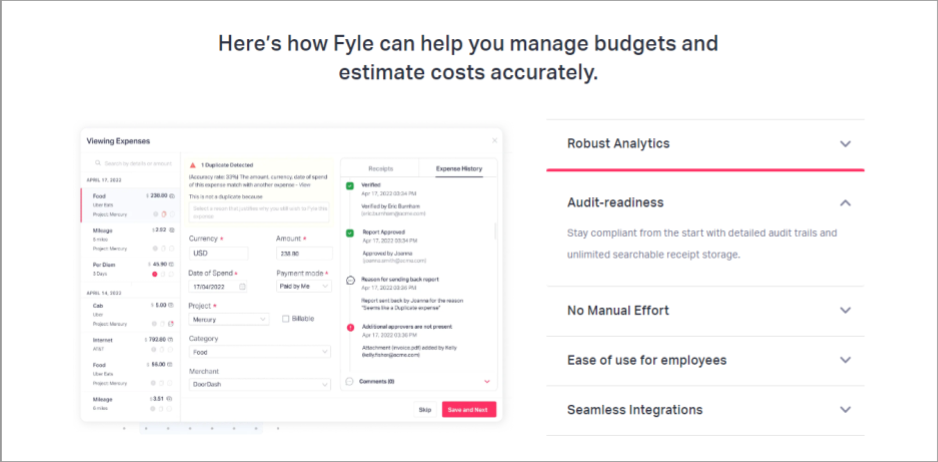
#3 USP
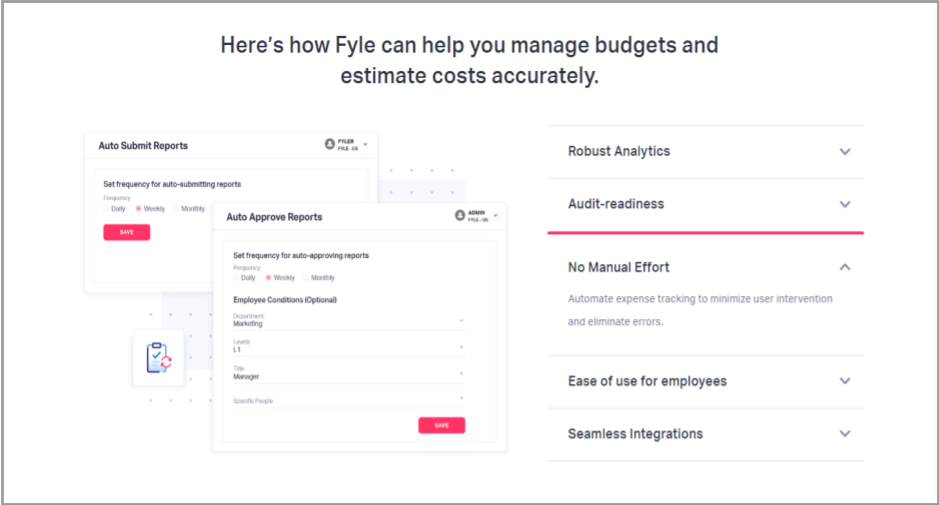
#4 USP
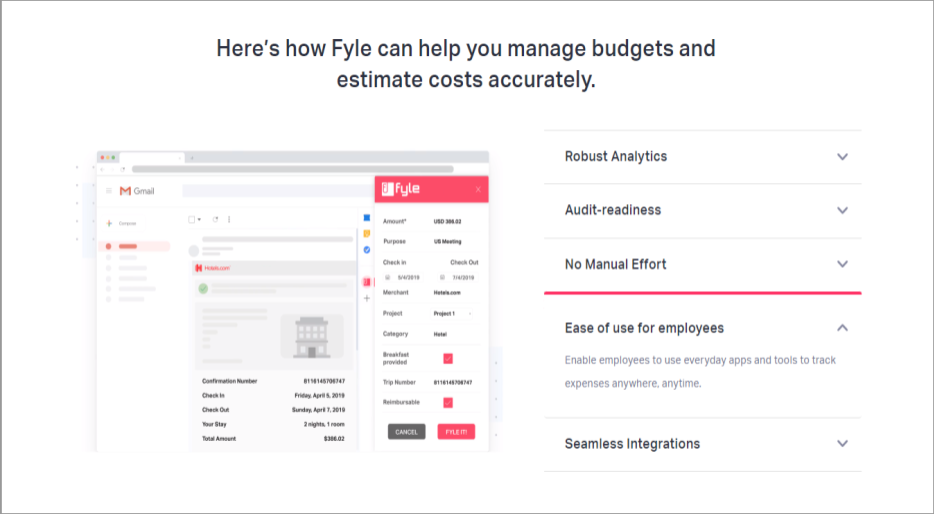
#5 USP
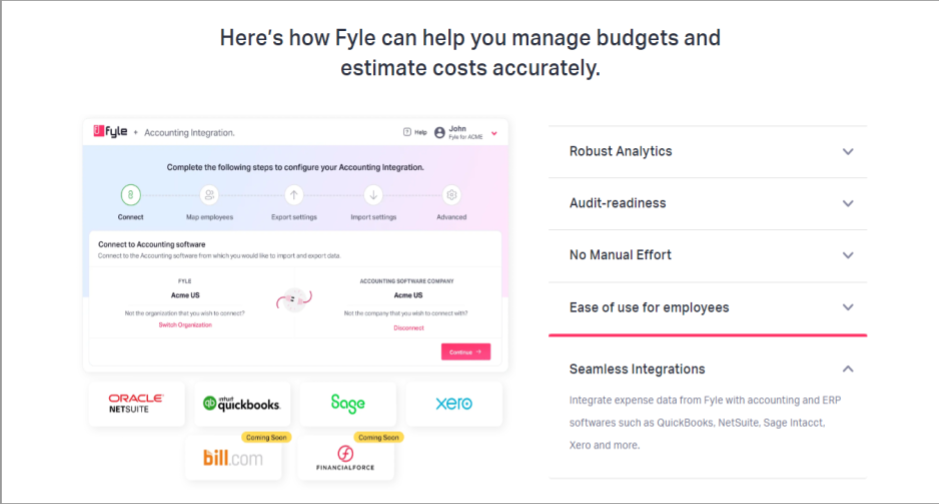
6) Closing CTA

The title triggers the pain points (poor expense management and unexpected overheads) and also the desire for better transformation (seamless and swift management). (✅ Know & Like factors.)
The higher ranks and review stars from one of the most reputable review platforms, “G2” are a sign of unshakable authority. (✅ Trust factor.)
CTA: Get a demo. The purpose of CTA is to encourage users to take specific action.
This CTA doesn’t directly ask the users to purchase something.
Instead, it encourages users to get something they would love to have before purchasing the product with complete satisfaction. (✅ Removes friction in taking action and so the convincing factor is checked off the list). So, it is CTV – Call-to-Value!
FYI: After clicking the CTA, website visitors are redirected to a form where Fyle gathers basic details about them via simple Q&As.
- Majority of the people interested in the product would be willing to share the details in order to get the demo.
- After qualifying the details, the sales team will contact them with persuasive pitches to convert them. (✅ Conversion factor is also checked off to onboard them as new clients!)
- And that’s all it is.
Verdict: The product position of Fyle on its landing page is absolutely phenomenal! You too agree. Don’t you?
All right. Now, it’s time for insightful tips from our observations on Fyle’s landing page. Without any further ado, let’s dive right into;
15 must-know tips on how to market a product or service
1) Understand Your Target Audience
To win your customers’ hearts, you need to understand their minds first. So, get to know your target audience inside-out: what they desire, what challenges they face, and what drives them.
By painting a crystal clear picture of your ideal customer, you can tailor your messaging and positioning so that it speaks directly to them and creates a powerful emotional connection.
This tailored approach will make your product irresistible and set you apart from the competition. Besides, understanding your audience is the golden key to groundbreaking success strategies.
For example, Fyle has profoundly understood its target audience and phenomenally positioned its feature-packed product on its website with its irresistible benefits.
2) Identify Your Unique Value Proposition (USP)
What sets your product apart from the sea of competitors? What makes it one-of-a-kind? Your unique value proposition (USP) should be the cornerstone of your product marketing strategy.
It should be the #1 feature that makes your product linger in the minds of your potential customers.
Got it? If not, let’s understand it by taking a look at some unshakable USPs of popular brands as examples.
- Apple’s iPhone – It has a USP of offering a seamless user experience, peerless privacy, and elegant design. We all know that, right?!
Nike – Nike’s brand promise of “Just Do It” highlights its USP of empowering athletes to push beyond their limits.
3) Focus on customer education
Yes. Don’t just sell your products; educate your customers and position yourself as a thought leader in your field!
Engage your audience with informative and valuable content such as blogs, social media posts, reels, videos, and webinars that offer practical insights and useful tips related to your product or service.
For example, a skincare company could create blog posts on the importance of SPF, how to identify your skin type, and how to create a skincare routine. Additionally, they could host webinars on the science behind their product formulas and offer Q&A sessions with their skincare experts.
By focusing on customer education, you build trust and establish a loyal customer base that will appreciate your dedication to their well-being and success.
4) Create a strong brand story
A captivating brand story can help you create a more meaningful and authentic relationship, one that is based on shared values and aspirations rather than just commercial exchange.
With so many options available, customers want to support brands that they can relate to and trust. That’s where storytelling comes in; it helps your brand stand out from the crowd and create a lasting impact.
For example, the brand TOMS has an inspiring brand story. For every pair of shoes bought, they donate a pair to a child in need. Through their story, TOMS has connected with millions of customers who feel good knowing that their purchase is making a positive impact.
Similarly, sharing real-world examples of how your product has positively impacted your customers’ lives can make your brand more relatable and trustworthy.
So, what is the takeaway? Tell your brand’s story and connect with your customers on a deeper level. It’s the magical potion to take your brand to the next level!
5) Leverage emotional triggers
Did you know that 90% of purchasing decisions are driven by emotions? That’s right—customers don’t just buy products; they buy experiences and feelings. That’s why tapping into emotional triggers like fear, happiness, or nostalgia can make all the difference in your marketing campaigns.
Imagine creating a connection with your customers that goes beyond the product itself—one that resonates on a deep emotional level. By leveraging these triggers, you can tap into the hearts and minds of your audience, driving more sales and building brand loyalty.
Let’s take Coca-Cola’s “Share a Coke” campaign as an example. By personalizing their cans and bottles with customers’ names, the company tapped into the emotion of nostalgia, reminding people of happy memories and encouraging them to share a Coke with someone they love.
The result? A hugely successful campaign that skyrocketed sales and strengthened customer relationships.
So? Don’t just sell products; sell emotions. Ask yourself: How can you tap into your customers’ hearts? Explore, implement, and experiment with your answers to watch your business soar to new heights.
6) Keep a Watchful Eye on Your Competition
You need to stay informed about your competitors’ every move. Keep an eye on their new product releases, marketing campaigns, and changes in their positioning strategies.
This information can help you make better-informed decisions about your own marketing strategies and product development, ultimately leading to your business’s success.
For example, in the tech industry, Apple and Samsung are always keeping an eye on each other’s releases. Whenever one launches a new product, the other quickly follows suit with a competing product to stay in the game. Haven’t you heard about selling smartphones without charges?
7) Highlight the Benefits, Not Just the Features
Isn’t it more important to communicate the benefits of your product to your customers than just the features? While features are important, benefits are the actual factors that sell products.
Imagine that if you’re marketing a new laptop, you need to highlight how your laptop’s larger screen size, faster processing speed, and long-lasting battery will improve your customer’s user experience.
This will give your potential customers a reason to choose your product over your competitors’.
Let’s take, as an example, the fitness brand “Fitbit,” which highlights the benefits of their products, such as improved health, rather than just the features, like the number of exercise modes they offer. This strategy has helped both companies stand out in a crowded market and capture a loyal customer base.
On the other hand, Fyle has nailed this tip on their landing pages. Let’s dive deeper into it in the upcoming sections.
8) Experiment with different marketing channels
To effectively reach your target audience in today’s fast-paced digital world, you must experiment with various marketing channels.
Rather than sticking to conventional methods like advertising and PR, try social media platforms like Facebook, Instagram, LinkedIn, Twitter, TikTok, and Reddit to promote your product and build your brand’s online presence.
Influencer marketing is another powerful way to boost your product’s visibility. Partner with influential people in your niche who have a vast following to showcase your products and create an authentic buzz.
With the eCommerce market booming, professional influencers and influential people have become more important than ever, offering various promotional opportunities, from product reviews to in-depth blog articles.
Examples: Promotional videos in YouTube shorts and Instagram reels are trending examples. And Hirect promotional posts on Linkedin that are buzzing among freelancers lately as well.
9) Keep your messaging consistent across all channels
In today’s cut-throat business arena, connecting with your target audience is key to the success of your marketing efforts. After all, it’s all about standing out from the crowd and leaving a lasting impression that resonates with your customers.
So, if you want to stay ahead of the competition and achieve your business goals, it’s essential to know how to create a strong bond with your target audience. Don’t you agree?
To accomplish this, ensure that your messaging is consistent across all channels, including your website, social media, and email marketing.
By ensuring that your messaging and positioning are aligned with your brand, you can establish trust with your audience, foster customer loyalty, and make your marketing efforts more effective.
For example, take the case of Nike, which has built a brand image that promotes athleticism, inspiration, and determination. Whether it is their social media posts, website content, or email newsletters, Nike’s messaging always resonates with their brand identity, making it easy for customers to connect with them.
10) Provide excellent customer service
But great messaging alone is not enough to build a strong customer base. You also need to provide excellent customer service that exceeds their expectations.
Positive word-of-mouth can be a game-changer in today’s social media-driven world. Satisfied customers will not only stay loyal to your brand but also become brand ambassadors, recommending your product to others.
For example, Amazon is renowned for its exceptional customer service, which has been a key factor in its success.
They are known to provide a quick resolution to customer queries, offer free returns, charming cashbacks, and refunds, and go above and beyond to make their customers happy.
This has helped them establish a loyal customer base and become a go-to destination for online shopping.
11) Connect with professionals
As a talented inventor or visionary entrepreneur, you know how to create amazing products. But when it comes to marketing them, you might find yourself struggling.
That’s where a product marketing manager comes in. By enlisting the help of an expert, you can take your product to the next level and effectively reach your target audience.
But even if you don’t have the budget for a dedicated product marketing manager, you can still leverage the power of email marketing and online advertising.
With tools like email list management services and targeted ad platforms, you can create personalized, effective campaigns that speak directly to your customers.
For example, let’s say you’ve developed a revolutionary new fitness device. By partnering with a product marketing expert or using email marketing tools, you can create targeted campaigns that showcase the benefits of your device to fitness enthusiasts. You can also use targeted ads to reach customers who have shown interest in similar products or fitness-related content.
12) Win over new customers with irresistible deals
Seal the deal with exclusive promotions and discounts.
Don’t miss out on the chance to offer limited-time offers or first-time customer discounts. Your potential customers will be tempted to try your product and keep coming back for more.
For example, “In celebration of Holi, Lenskart offered a 50–70% discount on all the specs they had in stock for a limited amount of time.” This campaign attracted the attention of a massive number of new customers.
13) Let your customers do the talking
Capitalize on the power of referrals. Satisfied customers can bring in new business for you, so reward them for spreading the word. Offer referral bonuses or discounts to encourage them to refer their friends and family.
The result? A highly effective way to acquire new customers.
For example, GPay launched a referral program that rewards customers for inviting others to use the platform. By referring friends and family, customers can earn a monetary reward. This initiative aims to encourage existing users to share their positive experience with others and attract new customers to GPay. It created a win-win situation!
14) Collaborate to conquer
Join forces with other brands in your industry to expand your reach and introduce your product to new audiences.
Look for opportunities to partner on joint campaigns, events, or promotions. Together, you can create a buzz that benefits both brands.
For example, have you come across any brands’ collaborative posts on Instagram or the collaborative posts of two personal brands on Linkedin? They are the actual examples you needed to understand this strategy of leveraging the followers of both parties.
15) Get your product in the spotlight
Generate buzz by giving away free products.
Giveaways to bloggers and influencers can lead to product reviews and social media shares, while incentivizing customers to leave reviews can boost your online reputation.
Remember, your product only has value if people know about it.
For example, YouTubers and social media influencers are often the lucky recipients of pre-launch mobile devices from businesses.
By reviewing and showcasing these products to their audience, influencers can create excitement and help generate buzz around the upcoming release.
It’s a win-win situation: businesses receive valuable feedback, while influencers build trust and credibility with their followers. It’s no wonder this strategy has become so popular!
Now then, with all these tips and insights, you are ready to promote your product (or service) effectively through strategic positioning.
- And in case you are looking for someone who can help you implement all the tips and insights that we have seen so far, we would love to help you, and reap requisite results!
- Let’s get on a FREE discovery call to tackle your obstacles with our tailored strategies : )
